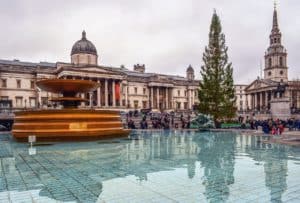The Great Colosseum of Rome: From Gladiators to Tourists

Updated On: November 10, 2023 by Maha Yassin
Rome, Italy, is one of the most visited cities in the world! People come from around the globe to spend a couple of days or weeks walking around the ancient city and visiting its countless tourist attractions. One attraction every visitor 100% visits or at least takes a picture with from afar is the Colosseum, which has been standing for centuries. The humongous building in the middle of the city will not be missed!
The Colosseum, also known as the Flavian Amphitheatre, is one of the most iconic and enduring symbols of ancient Rome’s architectural prowess and cultural might. This colossal structure, located at the heart of Rome, Italy, has captivated people’s imaginations worldwide for nearly two millennia. It is a testament to the advanced engineering skills of the Romans and their love for grand spectacles and entertainment.
Come with us on a journey to learn about the history of the Colosseum and what it means to Rome today, and get the best advice to have a perfect trip to see the ancient building.
The Colosseum of Ancient Rome
The Colosseum, a timeless symbol of ancient Rome’s architectural genius and imperial might, has stood tall in the heart of Rome for nearly two millennia. Its original purposes and the reasons behind its construction reveal much about the social, political, and cultural fabric of the Roman Empire during its heyday. We’re going to delve deep into the motives behind building the Colosseum and its original functions and shed light on how it served both as a tool of political propaganda and a venue for public entertainment.
Political Symbolism and Social Cohesion
Emperor Vespasian commissioned the construction of the Colosseum as a means of securing his power and legacy. The project was initiated shortly after the tumultuous Year of the Four Emperors (AD 69), a period marked by civil war and political instability. By building the Colosseum, Vespasian aimed to restore stability and earn the favour of the Roman people.
The amphitheatre was strategically built in place of an artificial lake that was part of Emperor Nero’s lavish palace complex, the Domus Aurea. By returning this land to public use, Vespasian was sending a clear message: his regime marked a return to republican values and a rejection of the excesses and tyranny of Nero’s rule. The Colosseum was a gift to the people of Rome, a tangible expression of the new emperor’s benevolence and commitment to the populace’s well-being.
A Venue for Grand Spectacles

The Colosseum was primarily designed to host a variety of public spectacles, serving both as a form of entertainment and as a tool of social control. The amphitheatre could accommodate over 50,000 spectators, providing them with a space to witness grand and often brutal events integral to Roman culture and society.
Gladiatorial Contests
The most famous events held in the Colosseum were undoubtedly the gladiatorial contests! Gladiators—often slaves, prisoners of war, or condemned criminals—fought to the death for the amusement of the crowd. This sounds horrible today (and it is!); however, back in the ancient days, Romans enjoyed that sort of thing. These contests were seen as a way to display Roman martial virtues, such as courage, skill in combat, and the will to win, while also serving as a means of socialising the populace to the values of the empire.
Animal Hunts
The Colosseum also hosted Venationes, or wild animal hunts, where exotic beasts from across the empire were pitted against gladiators or each other. These events showcased the empire’s vast reach and the empire’s ability to control and dominate nature itself.
Public Executions
In ancient times, you couldn’t have such a vast space and not use it for public executions! The amphitheatre was a venue for public executions, where condemned criminals were put to death in elaborate and gruesome spectacles. These executions served as both a form of entertainment and a stark warning to anyone who might defy the emperor’s authority!
Mock Sea Battles
The Colosseum was initially equipped with a complex system of aqueducts and could be flooded to host naumachiae or mock sea battles. These events, which recreated naval engagements, displayed Rome’s naval power and engineering prowess. The Romans were not big fans of the sea as they believed Neptune (the Roman god of the sea) did not favour them. However, that did not stop them from venturing into the waters or at least creating mock sea battles.
The Colosseum stands as a multifaceted symbol of ancient Rome, embodying the empire’s architectural ingenuity, its martial values, and its complex relationship with power and spectacle. Originally built as a means of consolidating power and securing political stability, the amphitheatre quickly became a centre of Roman public life, hosting a wide array of spectacles that entertained, awed, and controlled the populace.
Architectural Marvel

The Colosseum is renowned for its grandeur and architectural complexity. Designed to hold over 50,000 spectators, this elliptical amphitheatre is 189 metres long, 156 metres wide, and 48 metres high. It features four levels of arches and columns, each adorned with the three classical orders of architecture—Doric, Ionic, and Corinthian.
The amphitheatre was primarily used for gladiatorial contests, animal hunts, and public spectacles such as mock battles, dramas based on Classical mythology, and executions. The Colosseum’s arena had a complex set of underground tunnels and chambers that housed gladiators, workers, and animals. A series of pulleys and trapdoors allowed for elaborate and dramatic spectacles to unfold before the eyes of the audience.
Just as a building, the Colosseum is a marvel in and of itself! The fact that ancient Romans were able to build such a complex building without any of the modern technology we have today is awe-inspiring! Think of the Pyramids of Giza or the Great Wall of China. The Colosseum might not be a wonder of the world, but it is a marvellous creation.
The Colosseum of Today’s Rome
The Colosseum, an enduring icon of ancient Rome, continues to captivate the imaginations of millions around the globe to this very day. Standing tall amidst the ruins of the Roman Empire, this architectural marvel has transcended time to become one of the world’s most visited and recognised tourist attractions. Today, the Colosseum invites visitors to step back in time, explore its grandeur, and unravel the stories etched into its ancient stones.
A Global Tourist Magnet
Attracting over 7 million visitors annually, the Colosseum is a linchpin of Rome’s tourism industry. People from every corner of the world flock to witness this colossal amphitheatre, drawn by its historical significance, architectural brilliance, and the sheer magnitude of its presence. Whether bathed in the golden hues of the setting sun or illuminated against the night sky, the Colosseum never fails to leave an indelible mark on the hearts of those who behold it.
Educational and Cultural Experience
The Colosseum is not just a visual spectacle; it is a treasure trove of history and culture. Visitors have the opportunity to learn about the Roman Empire, its social structures, and its forms of entertainment. Guided tours and informational placards offer insights into the gladiatorial contests, animal hunts, and public spectacles that once took place within the amphitheatre’s walls. The Colosseum also serves as a living classroom for students and scholars, providing a direct link to the ancient world and its complexities.
Preservation and Restoration Efforts
Given its age and the wear and tear of millions of visitors each year, preserving the Colosseum is a monumental task. The Italian government, in partnership with various international organisations and private entities, has undertaken extensive restoration and conservation efforts to ensure that the Colosseum stands tall for future generations. These initiatives aim to stabilise the structure, clean and repair the stonework, and enhance the visitor experience through improved amenities and accessibility.
A Cultural Icon in Modern Media
The Colosseum, with its grandeur and historical significance, has cemented its place in modern media as a symbol of ancient Rome’s might and architectural brilliance. It frequently appears in films, television shows, and literature, often serving as a backdrop for epic tales of gladiators, political intrigue, and romance. Its imposing structure and the stories of brutal gladiatorial combat that once took place within its walls continue to capture the imagination of audiences worldwide.
Films that featured The Colosseum
The Colosseum has been featured in numerous films across different genres, showcasing its grandeur and the historical tales associated with it. Here are some notable examples:
- Gladiator (2000): Perhaps the most famous film featuring the Colosseum in recent times is Ridley Scott’s Gladiator. It is an epic historical drama starring Russell Crowe as Maximus, a Roman General who seeks vengeance against Commodus, the corrupt emperor who murdered his family and sent him into slavery. The film features intense gladiatorial combat scenes set in a digitally reconstructed Colosseum, capturing the brutal spectacle of ancient Rome’s favourite pastime.
- Roman Holiday (1953): This romantic comedy-drama stars Audrey Hepburn and Gregory Peck and features several iconic Roman landmarks, including the Colosseum. The film follows a royal princess who escapes her lavish life and falls in love with an American news anchor in Rome.
- Jumper (2008): In this sci-fi action film, the main character, David Rice, played by Hayden Christensen, has the ability to teleport and ends up in a chase scene that takes him through various global landmarks, including the Colosseum.
- The Lizzie McGuire Movie (2003): This teen comedy-drama film, based on the popular Disney Channel series, follows Lizzie McGuire as she goes on a school trip to Rome. The Colosseum features in several scenes, adding to the film’s Roman adventure.
- The Great Beauty (La Grande Bellezza) (2013): This Italian film, which won the Academy Award for Best Foreign Language Film, is a surreal journey through the lavish parties and quiet contemplative spaces of Rome, including a memorable scene at the Colosseum.
These films, among others, highlight the Colosseum’s versatility as a film location, serving as a backdrop for stories of romance, adventure, and historical drama. Its presence on the big screen continues to captivate audiences and solidify its status as an enduring symbol of ancient Rome. You can stream these movies and more that feature the ancient building on streaming services such as Netflix, Disney Plus, and Hulu.
5 Things to Keep in Mind While Visiting the Colosseum

Now that you know all about the history of the Colosseum and how it serves as a tourist attraction for Rome to this day, you must be excited to see it for yourself! Visiting Rome is a dream for many people, and seeing the Colosseum up close is one of the best experiences you can ever have! But being a top-rated tourist attraction means you need to make a solid plan before you visit. Here are some of our best advice about visiting the Colosseum.
Purchase Tickets in Advance
The Colosseum is one of Rome’s most popular tourist attractions, and it often attracts long lines, especially during peak tourist season, aka the summer! To save time and ensure entry, purchase your tickets in advance online. This will allow you to skip the ticket line and head straight to the security check. Some tickets also include access to the Roman Forum and Palatine Hill, providing a more comprehensive historical experience.
Choose the Right Time to Visit
To avoid the crowds and experience the Colosseum in a more serene setting, plan to visit early in the morning, right when it opens, or later in the afternoon when many tour groups have left. The lighting during these times can also provide better photo opportunities. Additionally, consider visiting during the off-peak season (late fall to early spring) when there are fewer tourists.
Stay Hydrated and Protected
Rome can get very hot and sunny, especially during the summer season. Ensure you stay hydrated by bringing a water bottle, and protect yourself from the sun with sunscreen, a hat, and sunglasses. There are water fountains around the Colosseum where you can drink, but why torture yourself in endless lines when you can bring your own bottle?
Wear Comfortable Shoes
We know you want to look good for your photos, but protecting your feet is a bit more important! The Colosseum and surrounding areas have uneven surfaces (they’re very old!) and require a fair amount of walking. Ensure you wear comfortable and sturdy footwear to navigate the site easily and prevent any potential foot discomfort.
Take a Guided Tour
To fully appreciate the history and architecture of the Colosseum, consider taking a guided tour. Knowledgeable guides can provide valuable insights, share fascinating stories, and answer any questions you might have, enriching your visit. Some tours also offer access to areas not open to the general public, such as the underground chambers and the upper tiers. It will cost a little more money, but we promise it’s worth it!
Visiting Italy is an excellent experience as it is one of the best tourist-friendly countries in the world! Rome is the main city everyone visits, but if you have time, make sure you also visit other cities, such as Venice (the city with the canals!), Florence (the city for art lovers!), and Verona (That’s where Shakespeare’s Romeo and Juliet takes place!).
The Colosseum is a testament to Rome’s historical grandeur and architectural prowess, a monument that has weathered the sands of time to remain one of the world’s most awe-inspiring tourist attractions. It invites visitors to embark on a journey through time, explore the depths of ancient Roman culture, and reflect on the endurance of human achievement. As both a physical structure and a cultural icon, the Colosseum continues to captivate, educate, and inspire, cementing its place as a must-visit destination for travellers from around the world.






